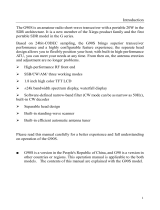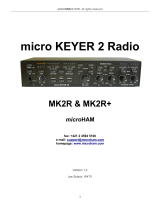
Page 17
FT DX 3000 OperaTing Manual
Front Panel Controls & switChes
PHONES Jack
A 1/4-inch, 3-contact jack accepts either monaural or
stereo headphones with 2- or 3-contact plugs. When
a plug is inserted, the loudspeaker is disabled.
Note:
When wearing headphones, we recommend that you
turn the AF Gain levels down to their lowest settings
before turning power on, to minimize the impact on
your hearing caused by audio “pops” during switch-
on.
Microphone Connector
This 8-pin jack accepts input from a microphone uti-
lizing a traditional YAESU HF transceiver pinout.
[ANT] Switch
Pressing this switch selects the ANT 1, ANT 2 or
the ANT 3 connector on the rear panel, and allows
convenient antenna switching at the press of a but-
ton. The selected antenna jack is indicated on the
Block Diagram Display shown in the Transceiver
Display.
Advice:
The ANT3 jack enables to use as an antenna for re-
ception only, using the Menu item “032 ANT3 SET-
TING”. See page 115.
[IPO] (
iNtercept poiNt optimizAtioN
) Switch
This button may be used to set the optimum front
end characteristics of the receiver circuit for a very
strong signal environment. Available selections are
AMP 1 (low distortion amplifier), AMP 2 (2-stage
low-distortion RF amplifier), or IPO (bypasses the
front end RF amplifier). The selected receiver RF
amplifier appears in the IPO column of the Block
Diagram Display on the display.
[ATT] Switch
This button selects the degree of attenuation, if any,
to be applied to the receiver input.
Available selections are –6 dB, –12 dB, –18 dB, or
OFF. The attenuation level appears in the ATT col-
umn of the Block Diagram Display on the display.
Advice:
The Attenuator may be used in conjunction with the
[IPO] button to provide two stages of signal reduc-
tion when an extremely strong signal is being re-
ceived.
[R.FLT] (
roofiNg filter
) Switch
Thisbuttonselectsthebandwidthofthereceiverrst
IF Roong Filter.Available selections are 300 Hz*,
600 Hz, 3 kHz, 6 kHz, 15 kHz, or Auto.
The selected bandwidth appears in the R.FLT column
of the Block Diagram Display on the TFT display.
*: Requires optional XF-127CN CW Narrow Filter.
Advice:
The “AUTO” selection mode selects the optimum
bandwidthoftheRoonglterforthereception
mode. In this case, the selected bandwidth in
the R.FLT column of the Block Diagram Dis-
play glows yellow (The unselected choices glow
Blue).
Because the roofing filter is in the first IF, the
protection it provides against interference is
quitesignicant.When settoAUTO,SSB,CW,
RTTY and DATA, the bandwidth is 3 kHz while
AM and FM is 15 kHz. On a crowded SSB band,
however,youmaywishtoselectthe600Hzl-
ter, for the maximum possible interference rejec-
tion.
[NB] Switch
This button turns the IF Noise Blanker on and off.
Press this button momentarily to reduce short-dura-
tion pulse noise.
Available selections are ON, OFF, or NBW ON. The
attenuation level appears in the NB column of the
Block Diagram Display on the display.
[AGC] Switch
This button selects the AGC characteristics for the
receiver. Available selections are FAST, MID, SLOW
and OFF, or AUTO. The selected AGC characteris-
tics appear in the AGC column of the Block Diagram
Display on the TFT display.
Press the [AGC] button repeatedly to select the de-
sired receiver-recovery time constant. Press and hold
in the [AGC] button for one second to disable the
AGC (for testing or weak-signal reception).
Advice:
The “AUTO” selection mode selects the charac-
teristics of the AGC for the reception mode. The
selected AGC characteristics will glow green in
the AGC column of the Block Diagram Display,
(unselected characteristics glow Blue).
The Attenuator may be used in conjunction with
the [IPO] button to provide two stages of signal
reduction when an extremely strong signal is be-
ing received.
If the AGC receiver-recovery time is set to “Off”
by pressing and holding in the [AGC] button, the
S-meterwillnolongerdeect.Additionally,you
will likely encounter distortion on stronger sig-
nals,astheIFampliersandthefollowingstages
are probably being overloaded.
[MOX] Switch
Pressing this button engages the PTT (Push to Talk)
circuit to activate the transmitter (the LED inside
this button will glow red). It must be turned off (the
red LED will be off) for reception. This button repli-
cates the action of the Push to Talk (PTT) switch on
the microphone. When engaging the [MOX] button,
or otherwise causing a transmission to be started,
be certain you have either an antenna or 50-Ohm
dummy load connected to the selected Antenna jack.





















